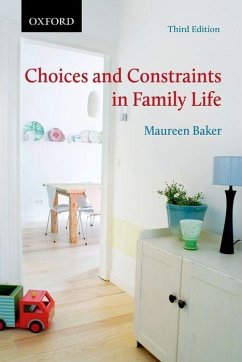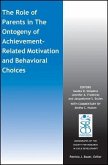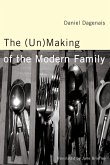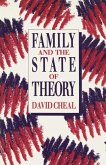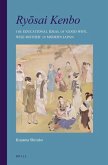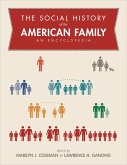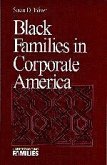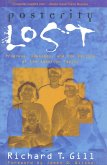Maureen Baker
Choices and Constraints in Family Life
Maureen Baker
Choices and Constraints in Family Life
- Broschiertes Buch
- Merkliste
- Auf die Merkliste
- Bewerten Bewerten
- Teilen
- Produkt teilen
- Produkterinnerung
- Produkterinnerung
The third edition of Choices and Constraints in Family Life is a concise yet comprehensive introduction to the sociology of the family.
Andere Kunden interessierten sich auch für
![The Role of Parents in the Ontogeny of Achievement-Related Motivation and Behavioral Choices The Role of Parents in the Ontogeny of Achievement-Related Motivation and Behavioral Choices]() The Role of Parents in the Ontogeny of Achievement-Related Motivation and Behavioral Choices48,99 €
The Role of Parents in the Ontogeny of Achievement-Related Motivation and Behavioral Choices48,99 €![The (Un)Making of the Modern Family The (Un)Making of the Modern Family]() Daniel DagenaisThe (Un)Making of the Modern Family41,99 €
Daniel DagenaisThe (Un)Making of the Modern Family41,99 €![Family and the State of Theory Family and the State of Theory]() David ChealFamily and the State of Theory50,99 €
David ChealFamily and the State of Theory50,99 €![Ryōsai Kenbo Ryōsai Kenbo]() Shizuko KoyamaRyōsai Kenbo67,99 €
Shizuko KoyamaRyōsai Kenbo67,99 €![The Social History of the American Family The Social History of the American Family]() The Social History of the American Family828,99 €
The Social History of the American Family828,99 €![Black Families in Corporate America Black Families in Corporate America]() Susan D ToliverBlack Families in Corporate America162,99 €
Susan D ToliverBlack Families in Corporate America162,99 €![Posterity Lost Posterity Lost]() Richard T GillPosterity Lost19,99 €
Richard T GillPosterity Lost19,99 €-
-
-
The third edition of Choices and Constraints in Family Life is a concise yet comprehensive introduction to the sociology of the family.
Hinweis: Dieser Artikel kann nur an eine deutsche Lieferadresse ausgeliefert werden.
Hinweis: Dieser Artikel kann nur an eine deutsche Lieferadresse ausgeliefert werden.
Produktdetails
- Produktdetails
- Verlag: Hurst & Co.
- 3rd edition
- Seitenzahl: 288
- Erscheinungstermin: 30. März 2014
- Englisch
- Abmessung: 226mm x 150mm x 15mm
- Gewicht: 363g
- ISBN-13: 9780199005376
- ISBN-10: 0199005370
- Artikelnr.: 39480596
- Herstellerkennzeichnung
- Libri GmbH
- Europaallee 1
- 36244 Bad Hersfeld
- gpsr@libri.de
- Verlag: Hurst & Co.
- 3rd edition
- Seitenzahl: 288
- Erscheinungstermin: 30. März 2014
- Englisch
- Abmessung: 226mm x 150mm x 15mm
- Gewicht: 363g
- ISBN-13: 9780199005376
- ISBN-10: 0199005370
- Artikelnr.: 39480596
- Herstellerkennzeichnung
- Libri GmbH
- Europaallee 1
- 36244 Bad Hersfeld
- gpsr@libri.de
Maureen Baker is professor in the Department of Sociology at the University of Auckland in New Zealand. From 1984 to 1990, she worked as a senior researcher for Canada's Parliament, specializing in social policy issues relating to families and women. From 1990 to 1997, she was an associate professor and professor at McGill University. Since January 1998, she has lived and worked in New Zealand. In 2008, she was made a fellow of the New Zealand Academy of the Humanities. In 2009, she was made a fellow of the Royal Society of New Zealand.
List of Tables and Boxes
Preface and Acknowledgements
1: : Variations in Family Life
Learning Objectives
Introduction
Defining Families
Historical Changes in Marriage and Families
Family Policies and the State
Gender, Class, Ethnicity, and Family Policies
Cultural and Historical Variations in Families
Family Structure
Authority and Lineage
Marriage Systems
Multiculturalism and Cultural Clashes
Conclusion
Questions for Critical Thought
Questions for Debate
Suggested Readings
Suggested Websites
2: : Theorizing and Researching Family Life
Learning Objectives
Introduction
Social Structure Shapes Family Patterns
Interpersonal Factors Shape Family Life
Ideas, Global Culture, and Public Discourse Influence Family Life
Theoretical Framework Used in This Book
Methods of Family Research
Conclusion
Questions for Critical Thought
Questions for Debate
Suggested Readings
Suggested Websites
3: : Forming Intimate Relationships
Learning Objectives
Introduction
The Social Regulation of Sexuality and Courtship
Dating and Sexuality in the Past
Early Patterns of Courtship and Engagement
Current Dating and Sexual Practices
Dating Abuse
Remaining Single
Finding Partners: Advertising versus Tradition
The Transition from Dating to Cohabitation
Rising Rates of Cohabitation
The Social and Policy Implications of Increased Cohabitation
Conclusion
Questions for Critical Thought
Questions for Debate
Suggested Readings
Suggested Websites
4: : Formalizing Relationships
Learning Objectives
Introduction
Negotiating the Transition from Cohabitation to Marriage
Who Marries Whom?
The Rise in Same-Sex Marriage
Legal Marriage Rates
Cultural Practices in Marriage
Preferred Marriage Partners and the Exchange of Gifts
Residence, Relations with Kin, and Surnames
Western Weddings and Marriage Practices
Marriage Quality
Male Violence against Female Partners
Barriers to Legal Marriage
Conclusion
Questions for Critical Thought
Questions for Debate
Suggested Readings
Suggested Websites
5: : Child-bearing, Child-rearing, and Childhood
Learning Objectives
Introduction
Parenting and Childhood in the Past
Fertility Patterns
Why Have Children?
Assisted Conception and Surrogacy
Pregnancy and Maternity Practices
Child-rearing Practices
Socialization and Gender Roles
Research on Fathering
Same-Sex Parenting
Parenting Challenges and Children's Well-Being
The Extension of Adolescence
Child Welfare Issues
State Support for Child-rearing
Conclusion
Questions for Critical Thought
Questions for Debate
Suggested Readings
Suggested Websites
6: : Household Work and Money
Learning Objectives
Introduction
Cohabitation, Marriage, and Housework
Early Studies of Household Work
Current Studies on Household Work
Household Work, Paid Work, and Stress
Household Money and Wealth Accumulation
Changing Labour Markets
Gender and Work
Employment and Parenthood
Dealing with Child Poverty
Parental Leave and Child-Care Subsidies for Employed Parents
Conclusion: The Growing Impact of Paid Work on Family Life
Questions for Critical Thought
Questions for Debate
Suggested Readings
Suggested Websites
7: : Separation, Divorce, and Re-partnering
Learning Objectives
Introduction
Why Are So Many Couples Separating?
Outcomes of Separation and Divorce
Family and Divorce Laws
Marriage, Gender, and Property
Reforms in Child Custody and Residence Patterns
Reforms in Assessment and Enforcement of Child Support
Children, Separation, and Divorce
Remarriage and Stepfamilies
Conclusion
Questions for Critical Thought
Questions for Debate
Suggested Readings
Suggested Websites
8: : Mid-life, Aging, and Retirement
Learning Objectives
Introduction
The Changing Meaning of Aging
Life Expectancy, the Life Cycle, and Aging
Mid-Life: Is It a Time of Security or Crisis?
Life Satisfaction and Marriage Stability
Grandparenting and Widowhood
Retirement Income and Pensions
Becoming Frail or Disabled
Does Aging Make People More Conservative?
Conclusion
Questions for Critical Thought
Questions for Debate
Suggested Readings
Suggested Websites
9: : Constraints on Personal Choices
Learning Objectives
Introduction
Predicting Future Family Patterns
Will People Still Get Married?
Will People Still Have Children?
How Will Couples Combine Earning and Caring?
Will Couples Stay Together?
Will Aging Be a Problem?
The Future of Family Studies
Questions for Critical Thought
Questions for Debate
Suggested Readings
Suggested Website
Glossary
References
Index
Preface and Acknowledgements
1: : Variations in Family Life
Learning Objectives
Introduction
Defining Families
Historical Changes in Marriage and Families
Family Policies and the State
Gender, Class, Ethnicity, and Family Policies
Cultural and Historical Variations in Families
Family Structure
Authority and Lineage
Marriage Systems
Multiculturalism and Cultural Clashes
Conclusion
Questions for Critical Thought
Questions for Debate
Suggested Readings
Suggested Websites
2: : Theorizing and Researching Family Life
Learning Objectives
Introduction
Social Structure Shapes Family Patterns
Interpersonal Factors Shape Family Life
Ideas, Global Culture, and Public Discourse Influence Family Life
Theoretical Framework Used in This Book
Methods of Family Research
Conclusion
Questions for Critical Thought
Questions for Debate
Suggested Readings
Suggested Websites
3: : Forming Intimate Relationships
Learning Objectives
Introduction
The Social Regulation of Sexuality and Courtship
Dating and Sexuality in the Past
Early Patterns of Courtship and Engagement
Current Dating and Sexual Practices
Dating Abuse
Remaining Single
Finding Partners: Advertising versus Tradition
The Transition from Dating to Cohabitation
Rising Rates of Cohabitation
The Social and Policy Implications of Increased Cohabitation
Conclusion
Questions for Critical Thought
Questions for Debate
Suggested Readings
Suggested Websites
4: : Formalizing Relationships
Learning Objectives
Introduction
Negotiating the Transition from Cohabitation to Marriage
Who Marries Whom?
The Rise in Same-Sex Marriage
Legal Marriage Rates
Cultural Practices in Marriage
Preferred Marriage Partners and the Exchange of Gifts
Residence, Relations with Kin, and Surnames
Western Weddings and Marriage Practices
Marriage Quality
Male Violence against Female Partners
Barriers to Legal Marriage
Conclusion
Questions for Critical Thought
Questions for Debate
Suggested Readings
Suggested Websites
5: : Child-bearing, Child-rearing, and Childhood
Learning Objectives
Introduction
Parenting and Childhood in the Past
Fertility Patterns
Why Have Children?
Assisted Conception and Surrogacy
Pregnancy and Maternity Practices
Child-rearing Practices
Socialization and Gender Roles
Research on Fathering
Same-Sex Parenting
Parenting Challenges and Children's Well-Being
The Extension of Adolescence
Child Welfare Issues
State Support for Child-rearing
Conclusion
Questions for Critical Thought
Questions for Debate
Suggested Readings
Suggested Websites
6: : Household Work and Money
Learning Objectives
Introduction
Cohabitation, Marriage, and Housework
Early Studies of Household Work
Current Studies on Household Work
Household Work, Paid Work, and Stress
Household Money and Wealth Accumulation
Changing Labour Markets
Gender and Work
Employment and Parenthood
Dealing with Child Poverty
Parental Leave and Child-Care Subsidies for Employed Parents
Conclusion: The Growing Impact of Paid Work on Family Life
Questions for Critical Thought
Questions for Debate
Suggested Readings
Suggested Websites
7: : Separation, Divorce, and Re-partnering
Learning Objectives
Introduction
Why Are So Many Couples Separating?
Outcomes of Separation and Divorce
Family and Divorce Laws
Marriage, Gender, and Property
Reforms in Child Custody and Residence Patterns
Reforms in Assessment and Enforcement of Child Support
Children, Separation, and Divorce
Remarriage and Stepfamilies
Conclusion
Questions for Critical Thought
Questions for Debate
Suggested Readings
Suggested Websites
8: : Mid-life, Aging, and Retirement
Learning Objectives
Introduction
The Changing Meaning of Aging
Life Expectancy, the Life Cycle, and Aging
Mid-Life: Is It a Time of Security or Crisis?
Life Satisfaction and Marriage Stability
Grandparenting and Widowhood
Retirement Income and Pensions
Becoming Frail or Disabled
Does Aging Make People More Conservative?
Conclusion
Questions for Critical Thought
Questions for Debate
Suggested Readings
Suggested Websites
9: : Constraints on Personal Choices
Learning Objectives
Introduction
Predicting Future Family Patterns
Will People Still Get Married?
Will People Still Have Children?
How Will Couples Combine Earning and Caring?
Will Couples Stay Together?
Will Aging Be a Problem?
The Future of Family Studies
Questions for Critical Thought
Questions for Debate
Suggested Readings
Suggested Website
Glossary
References
Index
List of Tables and Boxes
Preface and Acknowledgements
1: : Variations in Family Life
Learning Objectives
Introduction
Defining Families
Historical Changes in Marriage and Families
Family Policies and the State
Gender, Class, Ethnicity, and Family Policies
Cultural and Historical Variations in Families
Family Structure
Authority and Lineage
Marriage Systems
Multiculturalism and Cultural Clashes
Conclusion
Questions for Critical Thought
Questions for Debate
Suggested Readings
Suggested Websites
2: : Theorizing and Researching Family Life
Learning Objectives
Introduction
Social Structure Shapes Family Patterns
Interpersonal Factors Shape Family Life
Ideas, Global Culture, and Public Discourse Influence Family Life
Theoretical Framework Used in This Book
Methods of Family Research
Conclusion
Questions for Critical Thought
Questions for Debate
Suggested Readings
Suggested Websites
3: : Forming Intimate Relationships
Learning Objectives
Introduction
The Social Regulation of Sexuality and Courtship
Dating and Sexuality in the Past
Early Patterns of Courtship and Engagement
Current Dating and Sexual Practices
Dating Abuse
Remaining Single
Finding Partners: Advertising versus Tradition
The Transition from Dating to Cohabitation
Rising Rates of Cohabitation
The Social and Policy Implications of Increased Cohabitation
Conclusion
Questions for Critical Thought
Questions for Debate
Suggested Readings
Suggested Websites
4: : Formalizing Relationships
Learning Objectives
Introduction
Negotiating the Transition from Cohabitation to Marriage
Who Marries Whom?
The Rise in Same-Sex Marriage
Legal Marriage Rates
Cultural Practices in Marriage
Preferred Marriage Partners and the Exchange of Gifts
Residence, Relations with Kin, and Surnames
Western Weddings and Marriage Practices
Marriage Quality
Male Violence against Female Partners
Barriers to Legal Marriage
Conclusion
Questions for Critical Thought
Questions for Debate
Suggested Readings
Suggested Websites
5: : Child-bearing, Child-rearing, and Childhood
Learning Objectives
Introduction
Parenting and Childhood in the Past
Fertility Patterns
Why Have Children?
Assisted Conception and Surrogacy
Pregnancy and Maternity Practices
Child-rearing Practices
Socialization and Gender Roles
Research on Fathering
Same-Sex Parenting
Parenting Challenges and Children's Well-Being
The Extension of Adolescence
Child Welfare Issues
State Support for Child-rearing
Conclusion
Questions for Critical Thought
Questions for Debate
Suggested Readings
Suggested Websites
6: : Household Work and Money
Learning Objectives
Introduction
Cohabitation, Marriage, and Housework
Early Studies of Household Work
Current Studies on Household Work
Household Work, Paid Work, and Stress
Household Money and Wealth Accumulation
Changing Labour Markets
Gender and Work
Employment and Parenthood
Dealing with Child Poverty
Parental Leave and Child-Care Subsidies for Employed Parents
Conclusion: The Growing Impact of Paid Work on Family Life
Questions for Critical Thought
Questions for Debate
Suggested Readings
Suggested Websites
7: : Separation, Divorce, and Re-partnering
Learning Objectives
Introduction
Why Are So Many Couples Separating?
Outcomes of Separation and Divorce
Family and Divorce Laws
Marriage, Gender, and Property
Reforms in Child Custody and Residence Patterns
Reforms in Assessment and Enforcement of Child Support
Children, Separation, and Divorce
Remarriage and Stepfamilies
Conclusion
Questions for Critical Thought
Questions for Debate
Suggested Readings
Suggested Websites
8: : Mid-life, Aging, and Retirement
Learning Objectives
Introduction
The Changing Meaning of Aging
Life Expectancy, the Life Cycle, and Aging
Mid-Life: Is It a Time of Security or Crisis?
Life Satisfaction and Marriage Stability
Grandparenting and Widowhood
Retirement Income and Pensions
Becoming Frail or Disabled
Does Aging Make People More Conservative?
Conclusion
Questions for Critical Thought
Questions for Debate
Suggested Readings
Suggested Websites
9: : Constraints on Personal Choices
Learning Objectives
Introduction
Predicting Future Family Patterns
Will People Still Get Married?
Will People Still Have Children?
How Will Couples Combine Earning and Caring?
Will Couples Stay Together?
Will Aging Be a Problem?
The Future of Family Studies
Questions for Critical Thought
Questions for Debate
Suggested Readings
Suggested Website
Glossary
References
Index
Preface and Acknowledgements
1: : Variations in Family Life
Learning Objectives
Introduction
Defining Families
Historical Changes in Marriage and Families
Family Policies and the State
Gender, Class, Ethnicity, and Family Policies
Cultural and Historical Variations in Families
Family Structure
Authority and Lineage
Marriage Systems
Multiculturalism and Cultural Clashes
Conclusion
Questions for Critical Thought
Questions for Debate
Suggested Readings
Suggested Websites
2: : Theorizing and Researching Family Life
Learning Objectives
Introduction
Social Structure Shapes Family Patterns
Interpersonal Factors Shape Family Life
Ideas, Global Culture, and Public Discourse Influence Family Life
Theoretical Framework Used in This Book
Methods of Family Research
Conclusion
Questions for Critical Thought
Questions for Debate
Suggested Readings
Suggested Websites
3: : Forming Intimate Relationships
Learning Objectives
Introduction
The Social Regulation of Sexuality and Courtship
Dating and Sexuality in the Past
Early Patterns of Courtship and Engagement
Current Dating and Sexual Practices
Dating Abuse
Remaining Single
Finding Partners: Advertising versus Tradition
The Transition from Dating to Cohabitation
Rising Rates of Cohabitation
The Social and Policy Implications of Increased Cohabitation
Conclusion
Questions for Critical Thought
Questions for Debate
Suggested Readings
Suggested Websites
4: : Formalizing Relationships
Learning Objectives
Introduction
Negotiating the Transition from Cohabitation to Marriage
Who Marries Whom?
The Rise in Same-Sex Marriage
Legal Marriage Rates
Cultural Practices in Marriage
Preferred Marriage Partners and the Exchange of Gifts
Residence, Relations with Kin, and Surnames
Western Weddings and Marriage Practices
Marriage Quality
Male Violence against Female Partners
Barriers to Legal Marriage
Conclusion
Questions for Critical Thought
Questions for Debate
Suggested Readings
Suggested Websites
5: : Child-bearing, Child-rearing, and Childhood
Learning Objectives
Introduction
Parenting and Childhood in the Past
Fertility Patterns
Why Have Children?
Assisted Conception and Surrogacy
Pregnancy and Maternity Practices
Child-rearing Practices
Socialization and Gender Roles
Research on Fathering
Same-Sex Parenting
Parenting Challenges and Children's Well-Being
The Extension of Adolescence
Child Welfare Issues
State Support for Child-rearing
Conclusion
Questions for Critical Thought
Questions for Debate
Suggested Readings
Suggested Websites
6: : Household Work and Money
Learning Objectives
Introduction
Cohabitation, Marriage, and Housework
Early Studies of Household Work
Current Studies on Household Work
Household Work, Paid Work, and Stress
Household Money and Wealth Accumulation
Changing Labour Markets
Gender and Work
Employment and Parenthood
Dealing with Child Poverty
Parental Leave and Child-Care Subsidies for Employed Parents
Conclusion: The Growing Impact of Paid Work on Family Life
Questions for Critical Thought
Questions for Debate
Suggested Readings
Suggested Websites
7: : Separation, Divorce, and Re-partnering
Learning Objectives
Introduction
Why Are So Many Couples Separating?
Outcomes of Separation and Divorce
Family and Divorce Laws
Marriage, Gender, and Property
Reforms in Child Custody and Residence Patterns
Reforms in Assessment and Enforcement of Child Support
Children, Separation, and Divorce
Remarriage and Stepfamilies
Conclusion
Questions for Critical Thought
Questions for Debate
Suggested Readings
Suggested Websites
8: : Mid-life, Aging, and Retirement
Learning Objectives
Introduction
The Changing Meaning of Aging
Life Expectancy, the Life Cycle, and Aging
Mid-Life: Is It a Time of Security or Crisis?
Life Satisfaction and Marriage Stability
Grandparenting and Widowhood
Retirement Income and Pensions
Becoming Frail or Disabled
Does Aging Make People More Conservative?
Conclusion
Questions for Critical Thought
Questions for Debate
Suggested Readings
Suggested Websites
9: : Constraints on Personal Choices
Learning Objectives
Introduction
Predicting Future Family Patterns
Will People Still Get Married?
Will People Still Have Children?
How Will Couples Combine Earning and Caring?
Will Couples Stay Together?
Will Aging Be a Problem?
The Future of Family Studies
Questions for Critical Thought
Questions for Debate
Suggested Readings
Suggested Website
Glossary
References
Index

